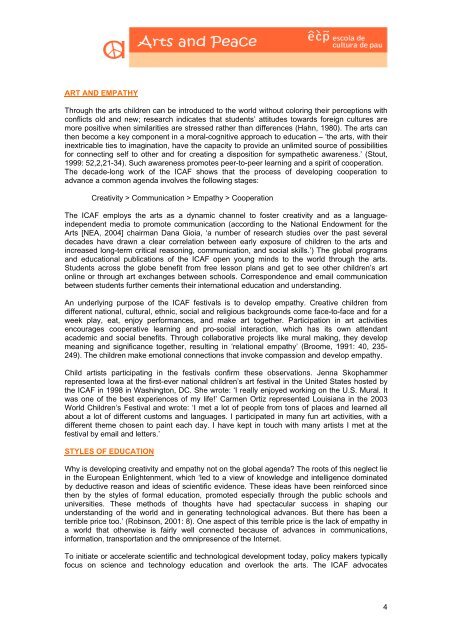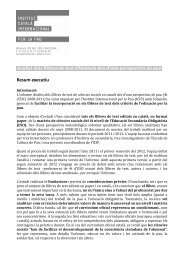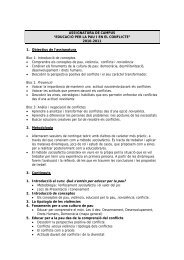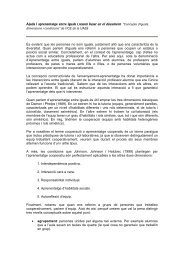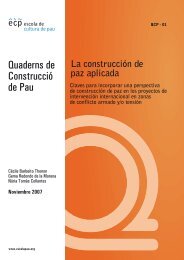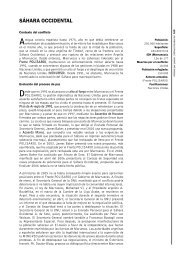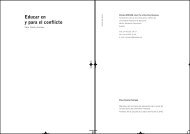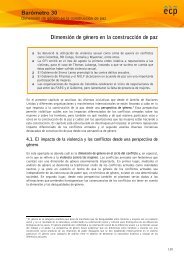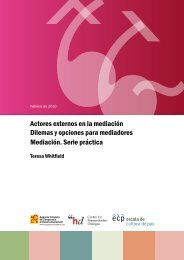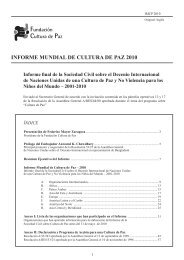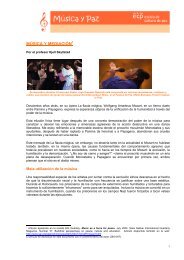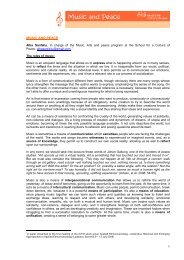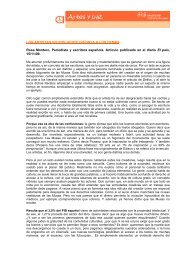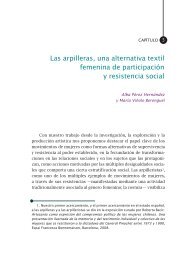PROSPERITY AND PEACE THROUGH ART
PROSPERITY AND PEACE THROUGH ART
PROSPERITY AND PEACE THROUGH ART
You also want an ePaper? Increase the reach of your titles
YUMPU automatically turns print PDFs into web optimized ePapers that Google loves.
<strong>ART</strong> <strong>AND</strong> EMPATHY<br />
Through the arts children can be introduced to the world without coloring their perceptions with<br />
conflicts old and new; research indicates that students’ attitudes towards foreign cultures are<br />
more positive when similarities are stressed rather than differences (Hahn, 1980). The arts can<br />
then become a key component in a moral-cognitive approach to education – ‘the arts, with their<br />
inextricable ties to imagination, have the capacity to provide an unlimited source of possibilities<br />
for connecting self to other and for creating a disposition for sympathetic awareness.’ (Stout,<br />
1999: 52,2,21-34). Such awareness promotes peer-to-peer learning and a spirit of cooperation.<br />
The decade-long work of the ICAF shows that the process of developing cooperation to<br />
advance a common agenda involves the following stages:<br />
Creativity > Communication > Empathy > Cooperation<br />
The ICAF employs the arts as a dynamic channel to foster creativity and as a languageindependent<br />
media to promote communication (according to the National Endowment for the<br />
Arts [NEA, 2004] chairman Dana Gioia, ‘a number of research studies over the past several<br />
decades have drawn a clear correlation between early exposure of children to the arts and<br />
increased long-term critical reasoning, communication, and social skills.’) The global programs<br />
and educational publications of the ICAF open young minds to the world through the arts.<br />
Students across the globe benefit from free lesson plans and get to see other children’s art<br />
online or through art exchanges between schools. Correspondence and email communication<br />
between students further cements their international education and understanding.<br />
An underlying purpose of the ICAF festivals is to develop empathy. Creative children from<br />
different national, cultural, ethnic, social and religious backgrounds come face-to-face and for a<br />
week play, eat, enjoy performances, and make art together. Participation in art activities<br />
encourages cooperative learning and pro-social interaction, which has its own attendant<br />
academic and social benefits. Through collaborative projects like mural making, they develop<br />
meaning and significance together, resulting in ‘relational empathy’ (Broome, 1991: 40, 235-<br />
249). The children make emotional connections that invoke compassion and develop empathy.<br />
Child artists participating in the festivals confirm these observations. Jenna Skophammer<br />
represented Iowa at the first-ever national children’s art festival in the United States hosted by<br />
the ICAF in 1998 in Washington, DC. She wrote: ‘I really enjoyed working on the U.S. Mural. It<br />
was one of the best experiences of my life!’ Carmen Ortiz represented Louisiana in the 2003<br />
World Children’s Festival and wrote: ‘I met a lot of people from tons of places and learned all<br />
about a lot of different customs and languages. I participated in many fun art activities, with a<br />
different theme chosen to paint each day. I have kept in touch with many artists I met at the<br />
festival by email and letters.’<br />
STYLES OF EDUCATION<br />
Why is developing creativity and empathy not on the global agenda? The roots of this neglect lie<br />
in the European Enlightenment, which ‘led to a view of knowledge and intelligence dominated<br />
by deductive reason and ideas of scientific evidence. These ideas have been reinforced since<br />
then by the styles of formal education, promoted especially through the public schools and<br />
universities. These methods of thoughts have had spectacular success in shaping our<br />
understanding of the world and in generating technological advances. But there has been a<br />
terrible price too.’ (Robinson, 2001: 8). One aspect of this terrible price is the lack of empathy in<br />
a world that otherwise is fairly well connected because of advances in communications,<br />
information, transportation and the omnipresence of the Internet.<br />
To initiate or accelerate scientific and technological development today, policy makers typically<br />
focus on science and technology education and overlook the arts. The ICAF advocates<br />
4


